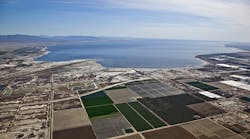Sponsored
Folks closely tracking the development of lithium resources in the United States have probably heard of the potential of the lithium underneath California’s Salton Sea, located approximately 160 miles east of Los Angeles, and the exploratory operations already underway there to develop to extract this lithium for EV batteries. California’s Governor Gavin Newsom says the area could be the “Saudi Arabia of Lithium,” and developers on site say the Salton Sea could one day provide half of the world’s supply of lithium.
They have reason to cheer the new findings of a recently completed study by the DOE’s Lawrence Berkeley National Laboratory showing that with expected technology advances, California’s Salton Sea region’s total resources could produce more than 3,400 kilotons of lithium, enough to support a mind-blowing 375 million-plus batteries for electric vehicles (EV) — more than the total number of vehicles currently on U.S. roads.
The press release issued by the Department of Energy (DOE) in late November said this confirms the region has significant potential as a domestic source of this critical mineral used in batteries for stationary storage and EVs, both of which are crucial to the Biden-Harris Administration’s goal of a net-zero emissions economy by 2050.
“Lithium is vital to decarbonizing the economy and meeting President Biden’s goals of 50% electric vehicle adoption by 2030,” said Jeff Marootian, principal deputy assistant secretary for DOE’s Energy Efficiency and Renewable Energy, in the press release. “This report confirms the once-in-a-generation opportunity to build a domestic lithium industry at home while also expanding clean, flexible electricity generation. Using American innovation, we can lead the clean energy future, create jobs and a strong domestic supply chain, and boost our national energy security.”
DOE says the United States currently has limited capabilities to extract, refine, and produce domestically sourced lithium, meaning nearly all lithium for U.S. needs must be imported. One large project that got underway in 2023 is the Thacker Pass mine in Nevada being developed by Lithiuim Americas.
Geothermal brines, which are a byproduct of geothermal electricity generation, often have high concentrations of minerals like lithium and zinc. While exact concentrations of these minerals depend on the location and surrounding geology, the use of direct lithium extraction (DLE) from geothermal brines offers a promising opportunity to couple clean, renewable electricity with a source of domestic lithium.
The Salton Sea Known Geothermal Resource Area (KGRA) has about 400 megawatts (MW) of geothermal electricity-generation capacity already installed and is estimated to have the potential for up to 2,950 MW, leaving extensive room to increase geothermal electricity generation while accessing more of the region’s available lithium resources — enabling the United States to meet or exceed global lithium demand for decades, according to the DOE report. Some of the companies already developing this resource include EnergySource and Warren Buffet’s BHE Renewables, which reportedly has 10 geothermal energy plants in the area.
A 60 Minutes report that aired in May 2023 says Energy Source is hoping to recover lithium from the area’s geothermal brine and reinject it back into the earth, a process that’s said to be much more environmentally friendly than traditional lithium mining methods. The report said EverSource hopes to have a commercially-viable lithium extraction process at its Salton Sea site underway by 2025.
The Geothermal Technologies Office (GTO) funded the lithium quantification report, part of DOE’s portfolio researching lithium extraction from geothermal brines. The portfolio also includes GTO’s recent American-Made Challenges Geothermal Lithium Extraction Prize and a joint $11 million R&D program, funded by the Advanced Materials and Manufacturing Technologies Office and supported by GTO, to develop and accelerate technologies for extracting and converting battery-grade lithium from geothermal brines.



